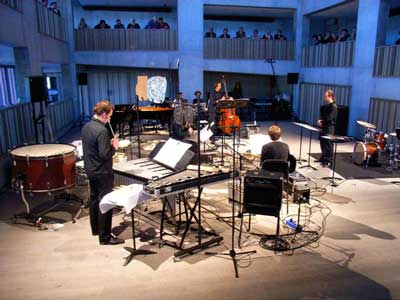COMPOSES
Memory Space #2
- duration:10'
- year:2005
- instrumentation:recorder, electric guitar, piano, percussion, double-bass & live-electronics
- commissioned by:Champ d'Action
- dedicated to:Serge Verstockt & Tomma Wessel
- recording:Champ d'Action Archives Series 06 - INTEGRATING THE RECORDER
- www.champdaction.be/nl/audio/
- full score
- mp3
Program Notes
The title, MEMORY SPACE # 2, refers to the installation of plastic artists Narcisse Tordoir and Koen De Decker, called NO MEMORY SPACE. In this installation, two “spaces” are seperated from eachother by a horizontal aluminium panel. The space below this panel, which is positioned very close to the floor, is filled with objects that can only be seen if one almost lies on the floor.
The small square hole made in the horizontal panel makes only a part of it visible when one looks from above. As a result, the “spectator” will never be able to “see” this piece of art as a whole, on the contrary, to obtain a “complete” image, the spectator has no other possibility than to go back to the images he stored in his memory of the parts he cannot see at a certain moment.

In MEMORY SPACE # 1 (for viola, bayan and live-electronics) and # 2 I elaborated upon this idea, which is of course even more present in music than in the plastical arts: one never has the “complete image” of a piece of music, since it’s spread out in time. In MEMORY SPACE # 2 I tried to create several layers of “memory”, which change constantly the “complete image”, the perspective of the piece.
First there is the “memory” of the composer, distilled in the score. Secondly, this composition is conceived as a kind of concerto for recorder and quartet, where the recorder states most of the musical material, and the quartet (generally) functions as a reservoir where this material will sediment (as it would do in ones memory).
Thridly, there is a technological (digital) memory, a “perfect” memory, which can be filled during the performance (through recording) with whatever material from the score, and later be “read” without any “distortions”.
In Memory Space # 2 (and # 1) this is done by a patch I wrote in the programming language MAX/MSP, which records fragments played by the individual musicians during the performance, and stores them in different places and on different layers in one single “memory unit”. In this process the chronological order of how it was played originally is consciously changed (fragment B, recorded after fragment A, can be put in front of fragment A in this “memory unit” – it’s even possible that fragment A and B are superimposed). When triggered, parts of this memory unit is being read (according to an algorythm which makes use of a kind of “forgetfulness”-principle) and send to the speakers, after being processed. This results in a constantly changing perspective of the past: while the performers continue playing the score (being very one-directional), parts of what they played before will sound through the speakers in a completely changed chronological order and “distorted” by different dsp-processes.
Fourthly, there is the “memory” of the performer, which is partly being “filled” or shaped during the process of studying the score, and later during performance. In the score, several blank spaces can be found. In these spaces, the performer has to improvise according to some (minimal) rules (see below), partly using material from the score. During these improvisations, the performer uses those elements (s)he remembered from before and processes them following his own laws (not those imposed by the composer). To do so, he uses not only his short-term memory and his physical memory. His long-term memory is being used as well, since his/her personal musical –and other- history is reflected some way or another in the improvisation. Even a “cultural memory” is being used in this process – the same “cultural” memory I partly and unconsciously called upon to compose the piece. To quote Jacques Derrida: “Even when one improvises in front of a camera or a microphone one ventriloquizes or leaves another to speak in one's place the schemas and languages that are already there. There are already a great number of prescriptions that are prescribed in our memory and in our culture. (...).
All these different kinds of memory, all using there own logic, are confronted with eachother in this composition.
This composition (premiered on 20/2/2006 at the Orpheus Institute, Gent) is commissioned by Champ d’Action and Tomma Wessel, and forms part of Tomma’s doctorate thesis. It’s warmly dedicated to both Tomma Wessel and Serge Verstockt.